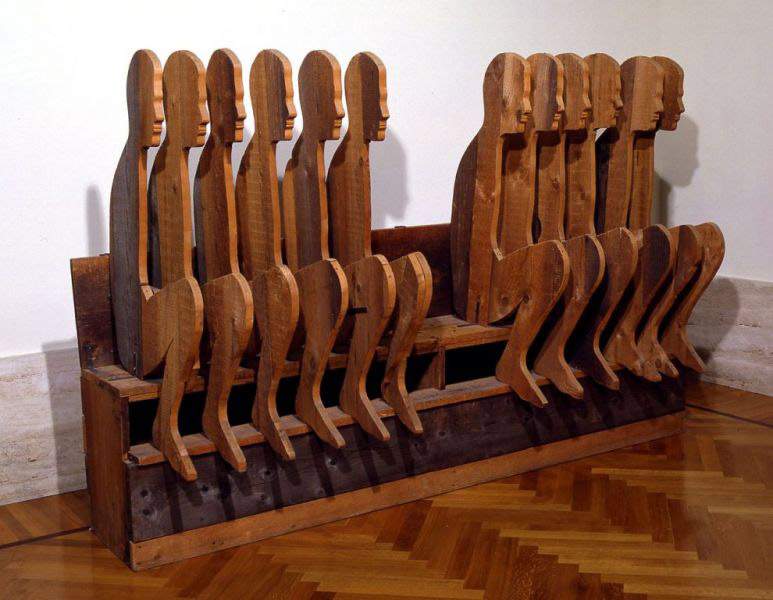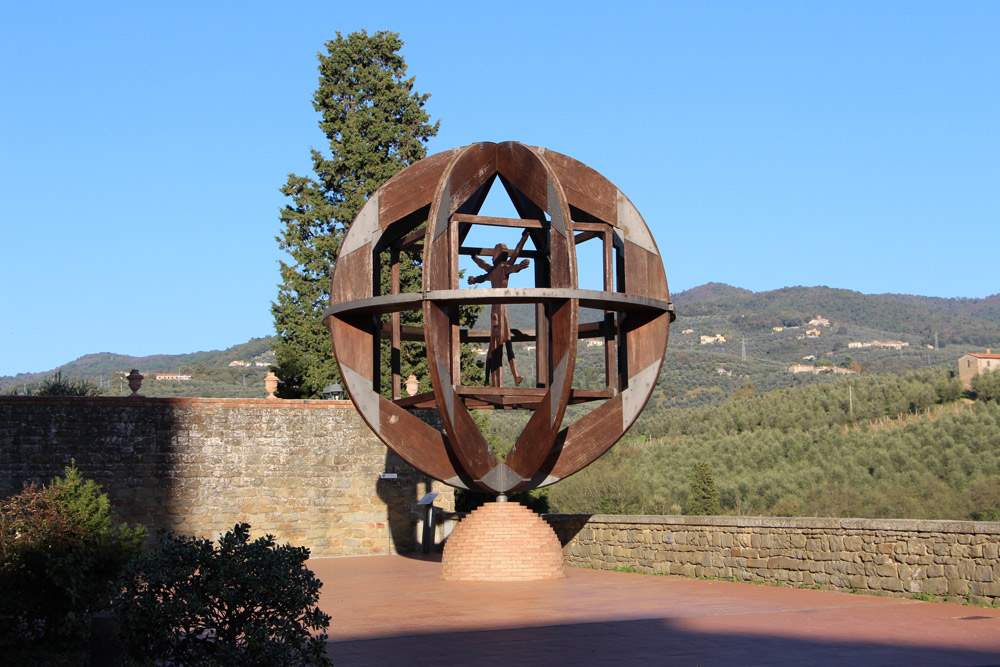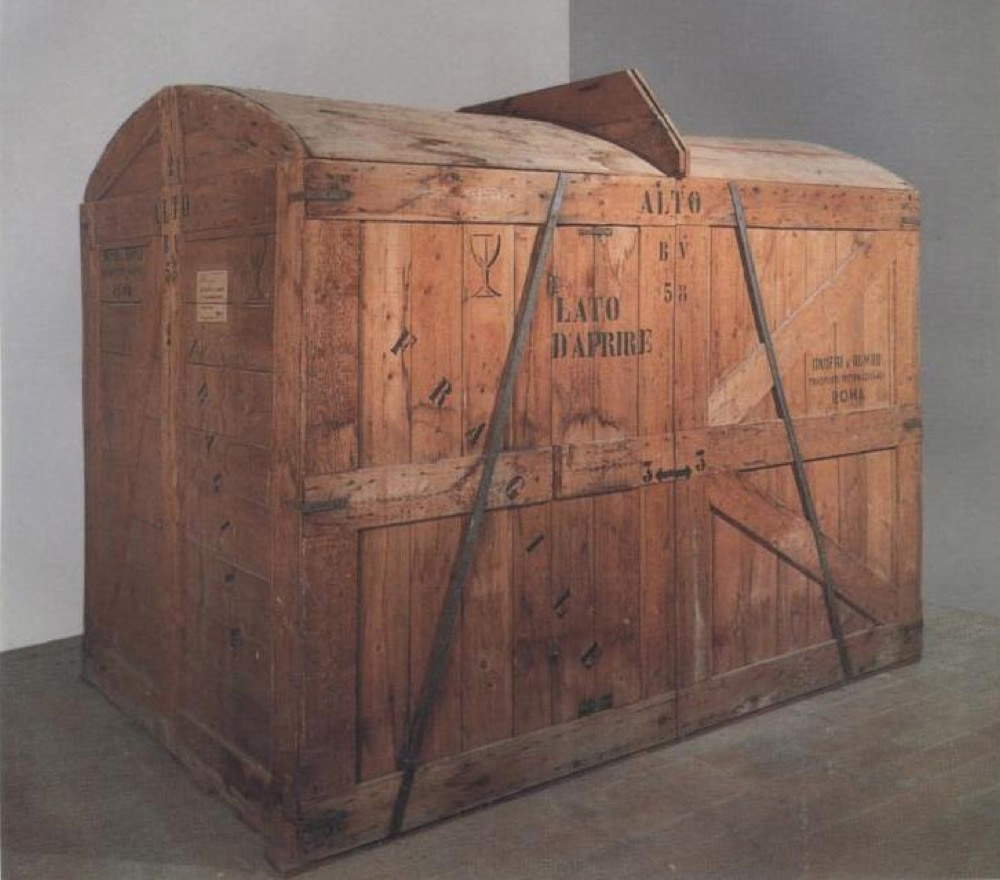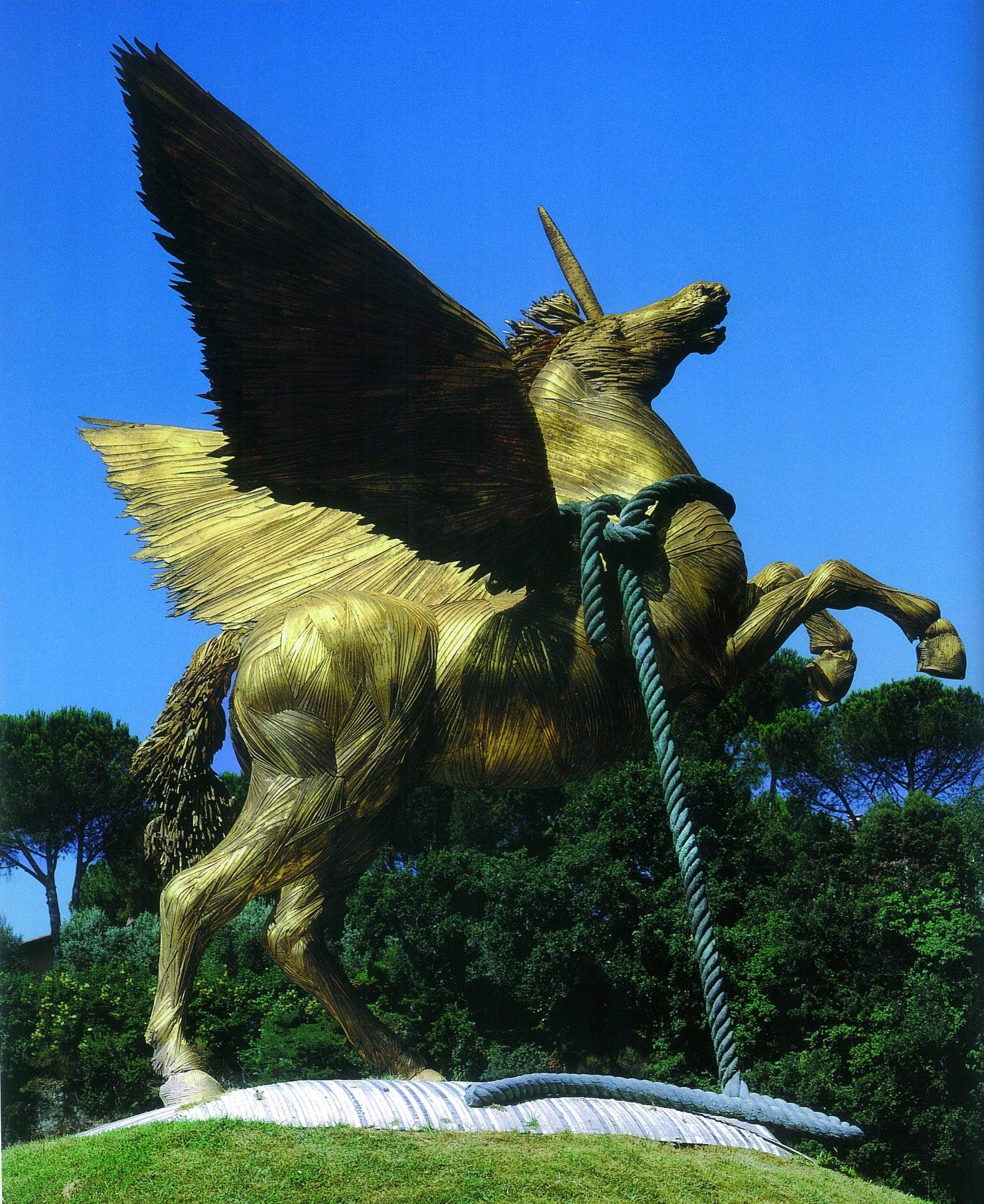Mario Ceroli (Castel Frentano, 1938) is a sculptor and scenographer known for “abolishing” the all round in sculpture, proving an innovator of this technique, and became famous for introducing a recurring figure, the silhouette. Ceroli used wood, his favorite material, to carve stylized human figures that he produced in series and placed side by side in sequence. In some cases, the silhouettes were drawn.
Another recurring theme in his production are the quotations from Leonardo da Vinci; in fact, he produced several personal reworkings of the famous Vitruvian Man, one of which can be found in the Fiumicino Airport, which is specifically dedicated to Leonardo, and another in Vinci(read an in-depth look at the work here). A large statue of a winged horse that can be seen at the entrance to the Rai studios in Saxa Rubra also bears his signature. Ceroli has also tried his hand at creating stage sets for theater, film and television.

Mario Ceroli was born on May 17, 1938, in Castel Frentano, a small town in Abruzzo, in the province of Chieti, and later moved to Rome where he studied at theAcademy of Fine Arts. Here he met sculptors Leoncillo Leonardi, Pericle Fazzini and Ettore Colla, and with them he completed his training, also becoming Colla’s assistant. Thanks to these contacts, Ceroli became interested in working with ceramics, but soon preferred wood, and thanks to some of his work he was awarded the prize for young Italian sculpture in 1958. This penchant for materials of humble origin made him to all intents and purposes a precursor of the Arte Povera group, and it is no coincidence that he participated with his works in some of the collective’s exhibitions in the late 1960s.
Precisely in the 1960s, Ceroli became very interested in U.S. Pop Art and in particular in the works of Louise Nevelson and Joe Tilson, whose influences would be present in his works, particularly in his famous silhouettes. One of the works of this type, Cassa Sistina, was also awarded a prize at the Venice Biennale in 1966.
An exhibition with a selection of his works was organized in 2007 on the occasion of the reopening of the Palazzo delle Esposizioni in Rome after a long period of closure for restoration. Over the years, the sculptor has created his own space in which to both live and work, as large as 3,000 square meters, located on the outskirts of Rome. Inside the residence are stored about 500 works that continue to increase over time. Ceroli’s intention would be to be able to open the doors of his impressive house-museum to the public, so as to make it a usable space that can also become a stimulus for new generations of artists.





Ceroli was an innovator in sculpture, as the intention that animated his practice was to abolish the all round. Ceroli’s earliest sculptural works are dated 1957 and made with wood, the material he most preferred at the time. They consist, in fact, of worked tree trunks, into which he inserted some nails. In the 1960s, Ceroli came into contact with Pop Art and began to reason about materials and forms, arriving at the idea of silhouettes, also known as silhouettes, that is, stylized human figures carved in raw wood devoid of paint, then left with its natural color. Ceroli often produced them in series, placing them one in front of the other or side by side, resulting in one of his most marked and recognizable stylistic figures. His best-known works include Last Supper (1965) and Leonardo’s Man (1964), two works in which, incidentally, he explicitly quotes the works of Leonardo da Vinci. Ceroli often used to include quotations from great works of the past in his works, including masterpieces by Michelangelo, Paolo Uccello and Giorgio de Chirico. He made another version of Leonardo’s Man in 1967, titled Squilibrio, which is now in the Fiumicino Airport “Leonardo da Vinci,” and another Vitruvian Man (1997) 30 years later, which he then donated to his hometown Castel Frentano. The sculpture is placed in the square in front of the Church of Our Lady of the Conception. In some cases, the silhouettes are connected to the surrounding space, as in Cassa Sistina (1966), or are traced with tempera or ink, as in The Door, The Cenacle (1981), Day and Night (1982). He also often proposes silhouettes of objects, as well as human ones.
In the 1980s, Ceroli created a number of works that became very famous, the first of which is the Winged Horse (1987), a large wooden statue painted gold that since 1990 welcomes, placed on an artificial hill, those who enter the Rai studios in Saxa Rubra. The hill was created for two reasons, both to allow better visibility of the sculpture and to express the concept of rebirth. In the site where the sculpture stands, some visual effects were applied, such as the insertion of some white pebbles illuminated by blue LEDs reminiscent of sea water, and also to make sure that the golden finish could be bright even at night, a projector with a very powerful beam of light was integrated, so as to ensure a striking visual impact.
He then made in 1988 the Casa del Nettuno, a wooden container that hid the Neptune statue in Bologna during restoration, on which Ceroli outlines a silhouette named Floating Man. On the occasion of the 1990 World Cup, which was held in Italy, he also created an imposing statue over 16 meters high entitled Goal Italia ’90, made of wood with the insertion of galvanized steel elements at the nodes and supports hooked to the ground. The work is a double reference both to the hexagons that make up classic soccer balls and to Leonardo ’s studies and in general to the philosophical and cosmogonic studies of the Renaissance. Initially placed in the Eur area, near the Pala Lottomatica, it was later moved near the Flaminio stadium where it still stands today.
Ceroli has also tried his hand very frequently with stage designs for theater, film, and television, and has also made designs for churches and their interior furnishings. He collaborated with the Teatro Stabile di Torino in making La grande Cina (1968), in which he used silhouettes by moving them through space as if they were suspended, and he also worked on the set design for Vincenzo Bellini’s Norma for La Scala in Milan in 1972. Some of Ceroli’s more recent works include a sculptural group in terracotta and marble entitled Silenzio: ascoltate! (2007), a sort of theatrical cavea section placed in Florence’s Children and Girls’ Square in Beslan, on which soar the silhouettes of “Florentine geniuses” such as Dante, Giotto, Ghiberti, Brunelleschi, Masaccio, Cellini, Cosimo il Vecchio, Lorenzo the Magnificent, Botticelli, Michelangelo, Leonardo, Amerigo Vespucci, Antonio Meucci and Roberto Benigni; and finally one of the last documented works turns out to be the commission that came in 2008 from the city of Siena to make the banner of the famous Palio.




Ceroli’s works can be found both in important Italian exhibition venues and in public places. Just in Castel Frentano, the sculptor’s birthplace, there is a version ofVitruvian Man (1997) in one of the main squares. Another version of the same work, entitled Squilibrio (Vitruvian Man) (1967), is also atFiumicino airport. Another version of the same work, from 1987, is in Vinci in Piazza del Castello.
Also in Rome, there is the presence of the statue Goal Italia ’90, currently placed near the Flaminio stadium, although as already pointed out it is in a state of neglect, and the Winged Horse (1987) in front of the Rai studios in Saxa Rubra. At the GNAM - National Gallery of Modern Art in Rome there is also theLast Supper (1965).
Again, it is possible to go to two churches to admire the interiors curated by Ceroli; these are the church of San Lorenzo in Porto Rotondo (1971) and the church of Santa Maria Madre del Redentore in Tor Bella Monaca (1987). Finally, a work by Ceroli entitled Balcone (1966) is in Spoleto, in the Museo Carandente, and in the CSAC - Centro studi e archivio della comunicazione in Parma there is a fund dedicated to Ceroli, only partially consultable, formed by two sculptures one of which turns out to be La grande Cina (1968).
 |
| Mario Ceroli, the sculptor who abolished the all round. Life, works, style |
Warning: the translation into English of the original Italian article was created using automatic tools. We undertake to review all articles, but we do not guarantee the total absence of inaccuracies in the translation due to the program. You can find the original by clicking on the ITA button. If you find any mistake,please contact us.